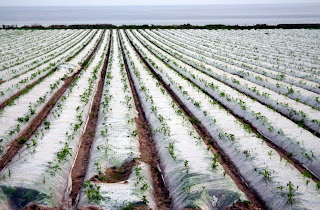







 Passing Renfrew on her way to Diesel Wharf.
Passing Renfrew on her way to Diesel Wharf.




 Planting the Ayrshire potatoes, some farmers plant their crops under a fleece to get them off to an early start,the Isle of Arran can be seen through the haze.
Planting the Ayrshire potatoes, some farmers plant their crops under a fleece to get them off to an early start,the Isle of Arran can be seen through the haze.



A concrete beach was created at Wemyss Bay during World War II, to provide a durable area where amphibious vehicles and landing craft could transition between land and sea. This would have been part of the preparations made by Combined Operations.
The weight of military vehicles, particularly if loaded with supplies, troops, munitions or armour, and the repeated passage of heavily treaded tyres, or tracks, would soon destroy an unprotected soft or sandy beach with a loose surface, rendering it useless. By laying a reinforced concrete surface over the original beach, it was possible to stabilise such areas, and use them continuously.
Here is a short account of someone who lived in the area at the time.
The Wemyss Bay beach which we knew as the shore road did have the concrete facility as is mentioned and was used by landing craft that came from somewhere and went up some lochs somewhere but we never found out where, such was the way of the war, but the concrete landing area certainly made a good outdoor swimming pool if the weather was good and the tide was in.
I was living at this time in a caravan in Kelly Estate in the avenue, a short distance from McIntyre's Kelly Mains farm, having moved down from Glasgow after the Clydebank blitz. The caravans were all well spaced out under the trees, unlike the present day, and the rent paid to Mr Bill McIntyre was £5.00 a year.
It was not unusual to be awakened in the wee small hours by the sound of army tanks, bren carriers and army lorries coming up into the estate and stopping under the trees to avoid detection from the air, also not realising that the caravans were all occupied thinking they could perhaps get a good billet for the night.
One particular instance, where having disturbed us during the night, the young English officer in charge apologised the next morning and stated that they were now leaving and taking the bridge to Rothesay. We explained there was no bridge to Rothesay and it transpired that he was looking for the Kincardine Bridge as they were going to Rosyth!
George Sneddon, Cumbernauld.
Information courtesy of secret Scotland.